

Home page,Bountiful Gardens website,Bountiful Gardens home. Economists say U.S. would save billions if pot was legal. T Posts And Accessories. Tractor Supply Company - Store Locator. Form301Suntop_install_brochure10-21-11PBW_web.pdf (application/pdf Object) F2203_PC_Care_and_Mntnce_Rev9-27-11_SCS.pdf (application/pdf Object) Soil and Health Library.
Soil Nutrient Analysis Laboratory. Mastergardener.htm. How to become a Master Gardener Is the UConn Master Gardener program for you?

To help you decide if you should apply for UConn Master Gardener training, ask yourself these important questions: Do I look forward to sharing my knowledge with people in the community? Do I have enough time to attend the 16 week training and to complete my 60 hours of volunteer work? Am I eager to participate in the practical and intensive training program? Certification. Geranium Care Overwintering Geraniums. Three super easy geranium care tricks for the cold winter months One of the reasons geraniums (Pelargonium) are so popular is because they flower all the time with such little effort on our part.

But, another more important reason, is because they are so forgiving. You can beat them up a bit and they come right back. They are of course considered a perennial, but in many cold winter areas they are treated as an annual, or they are grown indoors. Geraniums for all their beauty can only endure light frosts in the winter. RG316.pdf (application/pdf Object) The Seed Site. Chadwick, Alan (Informational Paper) Graduate Student, Center on Philanthropy at Indiana University “We need to create the beauty and the quality first.
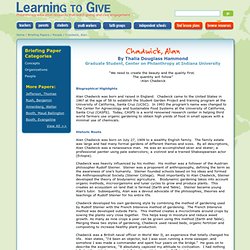
The quantity will follow” -Alan Chadwick Biographical Highlights Alan Chadwick was born and raised in England. Chadwick came to the United States in 1967 at the age of 58 to establish the Student Garden Project and training program at the University of California, Santa Cruz (UCSC). Historic Roots Alan Chadwick was born on July 27, 1909 to a wealthy English family. Hulless Barley - Agriculture - Government of Saskatchewan. Amaranth. Although several species are often considered weeds, people around the world value amaranths as leaf vegetables, cereals, and ornamental plants.

"Amaranth" derives from Greek ἀμάραντος[2] (amarantos), "unfading," with the Greek word for "flower," ἄνθος (anthos), factoring into the word's development as "amaranth. " The more accurate "amarant" is an archaic variant. Taxonomy[edit] Formerly, Sauer (1955) classified the genus into two subgenera, differentiating only between monoecious and dioecious species: Acnida (L.) Aellen ex K.R. The Far North Garden: How to Grow Gooseberries. Why have I never eaten a gooseberry?
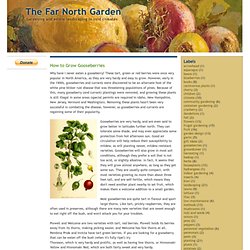
These tart, green or red berries were once very popular in North America, as they are very hardy and easy to grow. However, early in the 1900s, gooseberries and currants were discovered to be an alternate host of the white pine blister rust disease that was threatening populations of pines. Because of this, many gooseberry (and currant) plantings were removed, and growing these plants is still illegal in some areas (special permits are required in Idaho, New Hampshire, New Jersey, Vermont and Washington). Removing these plants hasn't been very successful in combating the disease, however, so gooseberries and currants are regaining some of their popularity. CURRANTS Fruit Facts. Ribes spp.
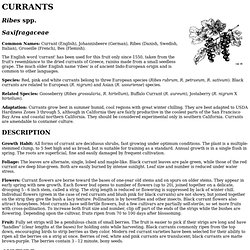
Saxifragaceae Common Names: Currant (English), Johannisbeere (German), Ribes (Danish, Swedish, Italian), Groseille (French), Bes (Flemish). The English word 'currant' has been used for this fruit only since 1550, taken from the fruit's resemblance to the dried currants of Greece, raisins made from a small seedless grape. The much older English name 'ribes' is of ancient Indo-European origin and is common to other languages. First and last freeze/frost dates for Stonington, Connecticut, United States. Cucumber Beetle Control. Cucumber Beetles Back to Insects Cucumber beetles (Diabrotica spp.- spotted and striped): Order: Coleoptera Family: Chrysomelidae For cucumber beetles: 1600 X-clude Formula 2, Pyrethrum Insecticide These bugs have yellowish-green colored bodies with black spots or stripes, a black head and are 1/4 inch in length.
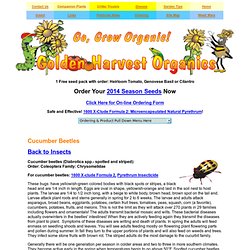
Generally there will be one generation per season in colder areas and two to three in more southern climates. Heavy infestations of the larva on corn will destroy the roots resulting in plants falling over. Cornell plant pathologists recommend scouting plants twice a week, especially when plants have less than five leaves. Thresholds for use of botanical or chemical control measures vary depending on species susceptibility to bacterial wilt. Predators: Tachnid flies, soldier beetles, parasitic nematodes and braconid wasps. Repellent plants: Broccoli, calendula, catnip, goldenrod, nasturtiums, radish, rue and tansy. Vegetable Nutrient Relationship. Understanding the vegetable nutrient relationship between your vegetables and your soil is an important aspect of organic gardening crop rotation.
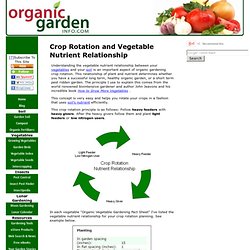
This relationship of plant and nutrient determines whether you have a successful long term, healthy organic garden, or a short term pest ridden garden. The principle I use to explain this comes from the world renowned biointensive gardener and author John Jeavons and his incredible book How to Grow More Vegetables This concept is very easy and helps you rotate your crops in a fashion that uses soil's nutrient efficiently. This crop rotation principle is as follows: Follow heavy feeders with heavy givers. After the heavy givers follow them and plant light feeders or low nitrogen users. In each vegetable "Organic Vegetable Gardening Fact Sheet" I've listed the vegetable nutrient relationship for your crop rotation planning. Heavy Feeder These vegetables extract a lot of nutrients from the soil during their growing period. Heavy Giver Light Feeder. Quinoa. pH for the Garden. University of Vermont ExtensionDepartment of Plant and Soil Science pH for the Garden OH 34 Leonard Perry, Extension Professor What is soil pH?
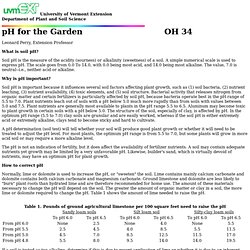
Soil pH is the measure of the acidity (sourness) or alkalinity (sweetness) of a soil.